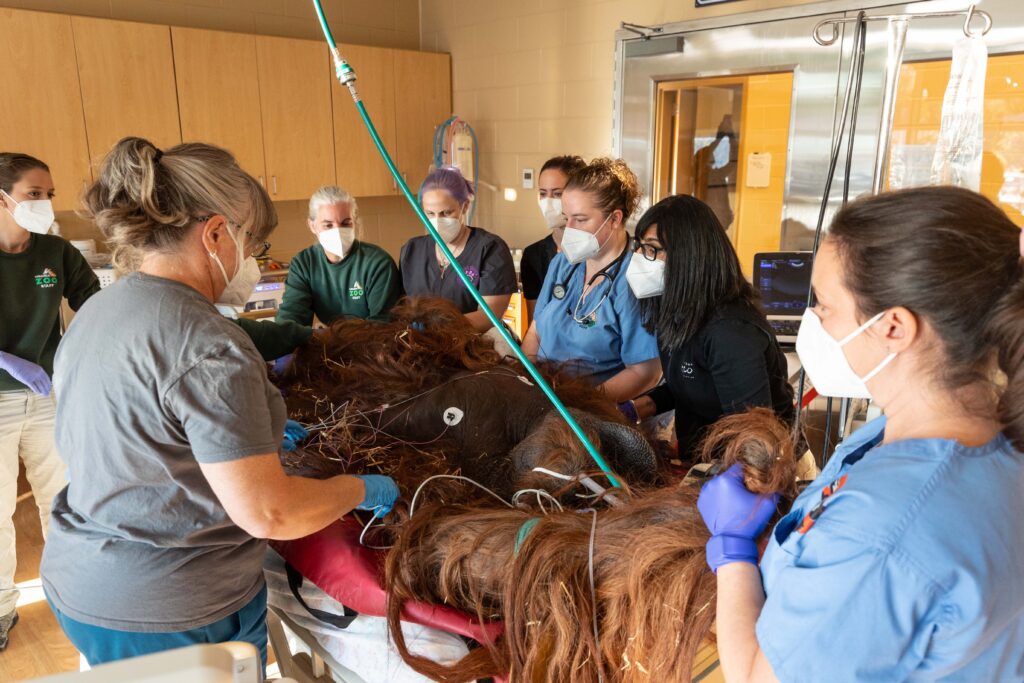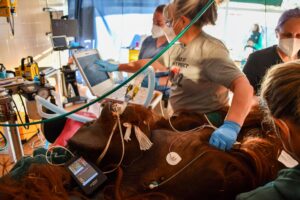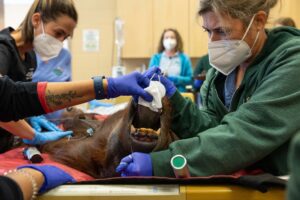Receiving the APE-solute best care at the Virginia Zoo
The journey to understanding cardiovascular disease
Editor’s note: All 4 of our orangutans were found to be in great health during these examinations, and the procedures went smoothly. We’d like to extend a special thanks to our partners at the Great Ape Heart Project, based at the Detroit Zoo; the Columbus Zoo veterinary team; and our local internal medicine specialist — we couldn’t have performed such thorough exams, which are vitally important to the wellbeing of our animals, without your help.

The Virginia Zoo first welcomed orangutans in 2010 and officially became home to one of the most unique species of great ape, about which we still have a lot to learn. Today, we are proud to have four adult orangutans – Schnitz (41), Pepper (43), Solaris (20), and Dara (24) – whose intriguing personalities have made them beloved residents of the Zoo by both guests and our animal care team.
All three species of orangutan – Bornean, Sumatran and Tapanuli – are listed as critically endangered in the wild by the International Union for the Conservation of Nature (IUCN), making their representation in zoos an increasingly important part of education and conservation. Unfortunately, cardiovascular disease has been identified as a major cause of morbidity and mortality in orangutans, gorillas, and other great apes living in human care. Diseases like this threaten conservation efforts to increase the orangutan population, and because little is known about cardiovascular disease in orangutans, the race is on to determine the cause.

The Great Ape Heart Project (GAHP), based at the Detroit Zoo, was founded in 2010 with the goal of collecting and analyzing cardiac data to investigate and understand heart disease in great apes amongst the zoo community. As a part of the Virginia Zoo’s routine anesthetized health evaluations, we were excited to have the opportunity to partner with the GAHP for a complete cardiac work-up of our orangutans. We hosted board-certified veterinary specialists from the Columbus Zoo and a local veterinary internal medicine specialist. Along with our on-site veterinary team, these great-ape specialists performed advanced imaging on our orangutans, including radiographs, echocardiograms, and abdominal ultrasounds.
When it comes to evaluating heart health, the echocardiogram is especially important. Also known as an ultrasound of the heart, an echocardiogram takes a multi-dimensional picture of the heart muscle in action, allowing cardiologists to examine its function and evaluate for cardiac conditions. This imaging, along with all of the data collected during these exams, helps further the GAHP’s mission of better understanding the health and longevity of orangutans across the world.

Our veterinary team took full advantage of this opportunity to gather additional data recommended by the orangutan Species Survival Plan (SSP). They monitored blood oxygen levels, blood pressure, heart rate, and respiratory rate and collected blood, urine, and saliva samples to check for any abnormalities. The team also performed abdominal ultrasounds to check the intestines, liver and kidneys, and took x-rays of the chest, abdomen, arms and legs. All of these examinations were performed while the animals were under anesthesia, which allowed our care team to perform thorough health evaluations in a controlled environment.
Procedures like this one can take a small village to ensure things run smoothly and safely. Our Asia keeper team spends a great deal of time training our orangutans through positive reinforcement to participate voluntarily in wellness checks — receiving vaccines, presenting body parts to be examined, and allowing blood pressure and heart rate to be monitored — so that in the future, we will be able to more regularly monitor their health status while they’re awake, creating a less frequent need for anesthetized examinations, which have inherent risks.